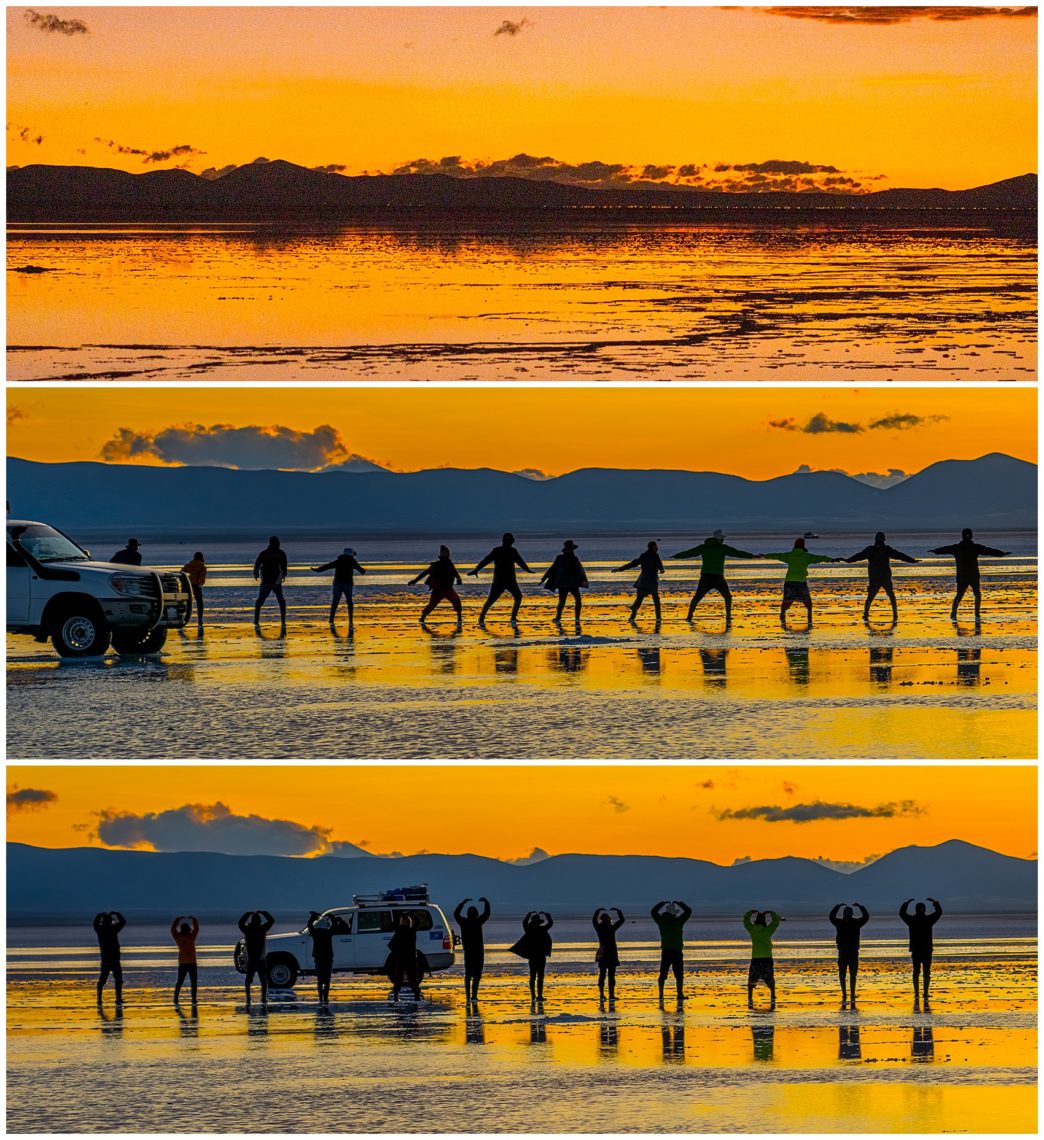
The primary goal in going to Bolivia was to see the Uyuni Salt Flats. For years, we have seen photos of a mirror-like surface that stretched for miles, and we wanted to see it (and photograph it, of course!) for ourselves. We decided to go to Bolivia in the rainy season on a “private tour,” with the two of us, one guide and one driver. Our tour operator Kuoda Travel did an excellent job of providing a guide who was reasonably knowledgable about photography, as he had led private tours with other professional photographers in the past. Both the guide and the tour agency were also extremely flexible, responding to our needs — both physical (16,000′ elevation at our age meant we were moving slowly!), and based on our evolving interests as the trip advanced.
Alas, the mirror effect only occurs when there have been recent rains, and climate changes have resulted in a drought on the salt flats for the past year. With no recent rains, we only found small pockets of water with enough water to show any reflections. The wind also acted to make our photographic life more difficult by creating constant ripples across the thin layer of water, destroying the mirrors (center and bottom image foregrounds).
We arranged a couple of sunrises on the salt flats, and Alvaro (our guide) brought us to this location on our first morning on the salt flats. With the sun coming up, we had the view on the top row above. Beautiful colors… but a bit drab. What was missing?
Oh… We were being “followed” by a group of 15 Korean tourists, who seemed to show up everywhere we went this week. Sure enough, as the sun began to rise, they parked RIGHT IN FRONT OF US! Breathe… In… Out… Oh, wait… Maybe they did not ruin our shot after all…
The Koreans lined up and posed, while one of their guide cars drove around them with an iPhone and stabilizer shooting video of them (bottom two rows). When I looked at the photos back in my studio, and my blood pressure had returned to normal… I decided they actually added an interesting element to the sunrise photos. ☺
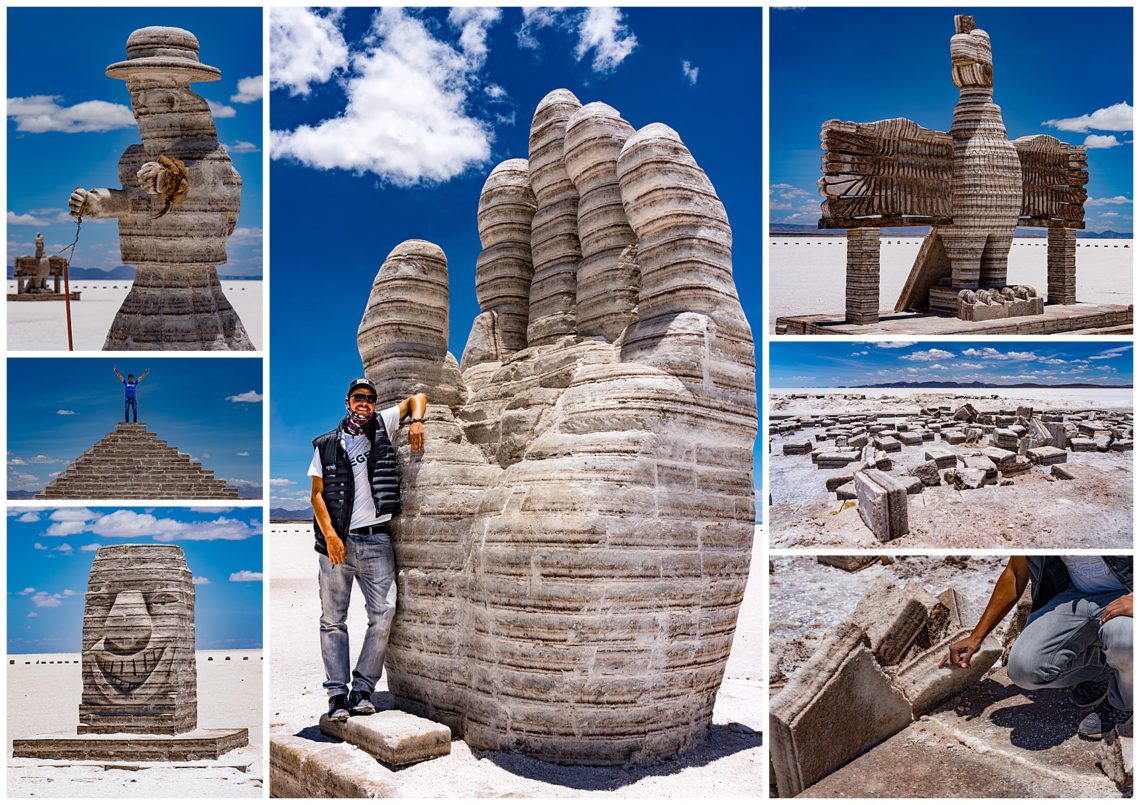
Our guide described a stop later in the day as “The Hand Of God.” This turned out to be a section of the salt desert set aside for artists to create sculptures entirely out of salt. It was actually not called “The Hand of God” as a region, but rather one specific sculpture was named such — as seen in the center image above, with our guide leaning on it. Yep. Our guide was the artist that created that particular salt sculpture. ☺
The area also had many other artist sculptures, entirely made of salt from the desert, as seen in the other images. Center-right can be seen a section of the field that has been cut up to provide salt blocks to the artists, while our guide kneels and points out the layers on the salt in the lower-right photo. The thickness of the layers here are very analogous to the rings on trees, and tells not only the age of the layer, but also the water environment of each year — thick layers being evidence of a wet year, while thin layers (like 2022) being evidence of a relative drought.
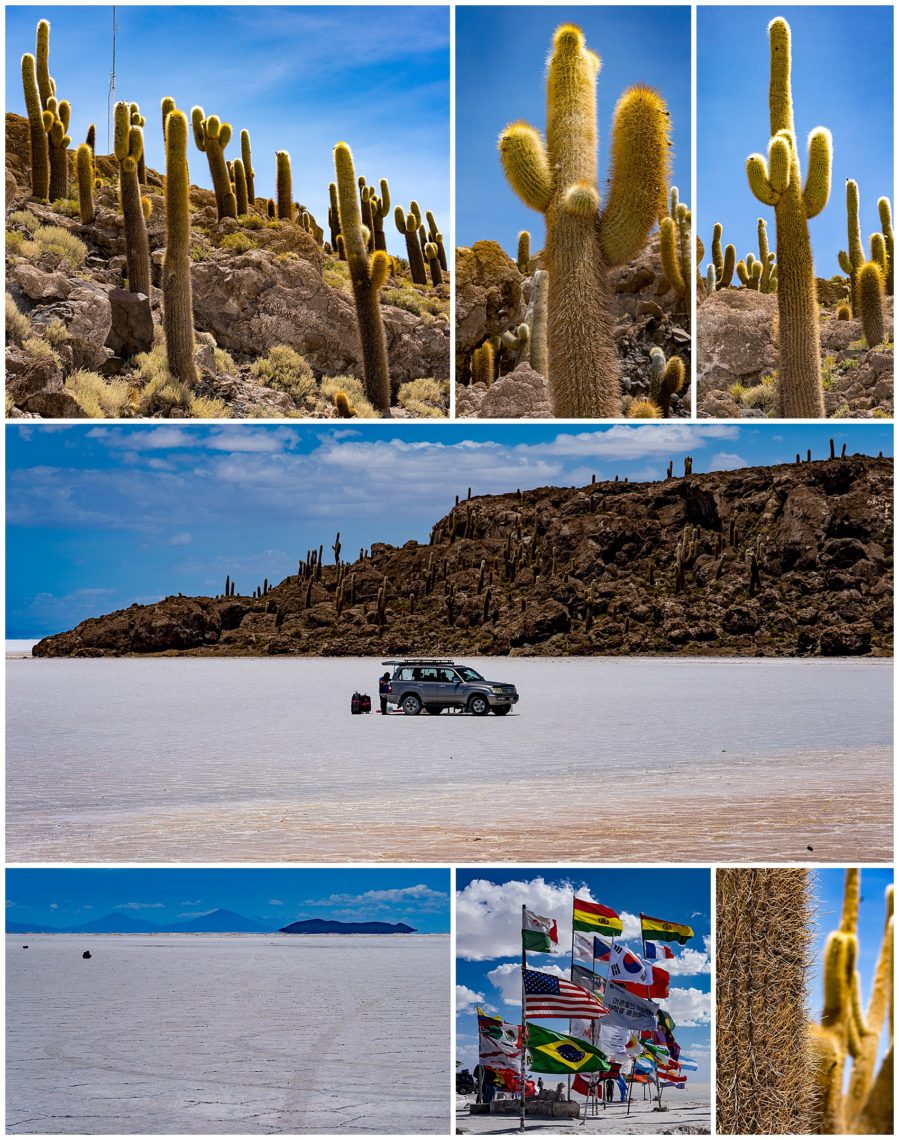
After visiting the salt art display area, we drove for an hour across the salt to have lunch at an “island” called Isla Incahuasi. Personally, when I think of island, I envision a rock outcropping from water. I was therefore having trouble visualizing when our guide kept saying we would have lunch at an island on the salt flat…?
Aha! An island does indeed refer to a rocky outcropping, but the area around it does not need to be wet. In this case, it was a dry seabed of the Salt Flats. After driving for a seemingly endless stretch over salt with no roads (lower-left), we finally came to our “island” and parked (center). These islands look like they’re floating in a mirage from a distance. This rocky outcropping was filled with cactus, which I never expected in such a salty area (top row and lower-right). While there, a very nice picnic table was brought out, with elegant silverware, wine, and a rather delicious cold lunch.
After lunch, we drove a short distance to the location of the original salt flat hotel, at which point dozens of flags could be seen planted (bottom-center). We were told that visitors planted their national flags at the site. The wind was so severe that some of the older flags were rather tattered, while others had clearly been replaced more recently with less damaged flags. I briefly considered sending up my drone for an aerial view, but a quick look at the position of those flags (ie, straight horizontal), shows how hard the wind was blowing. Combined with an altitude of 12,000 feet, I decided to keep my drone grounded…!
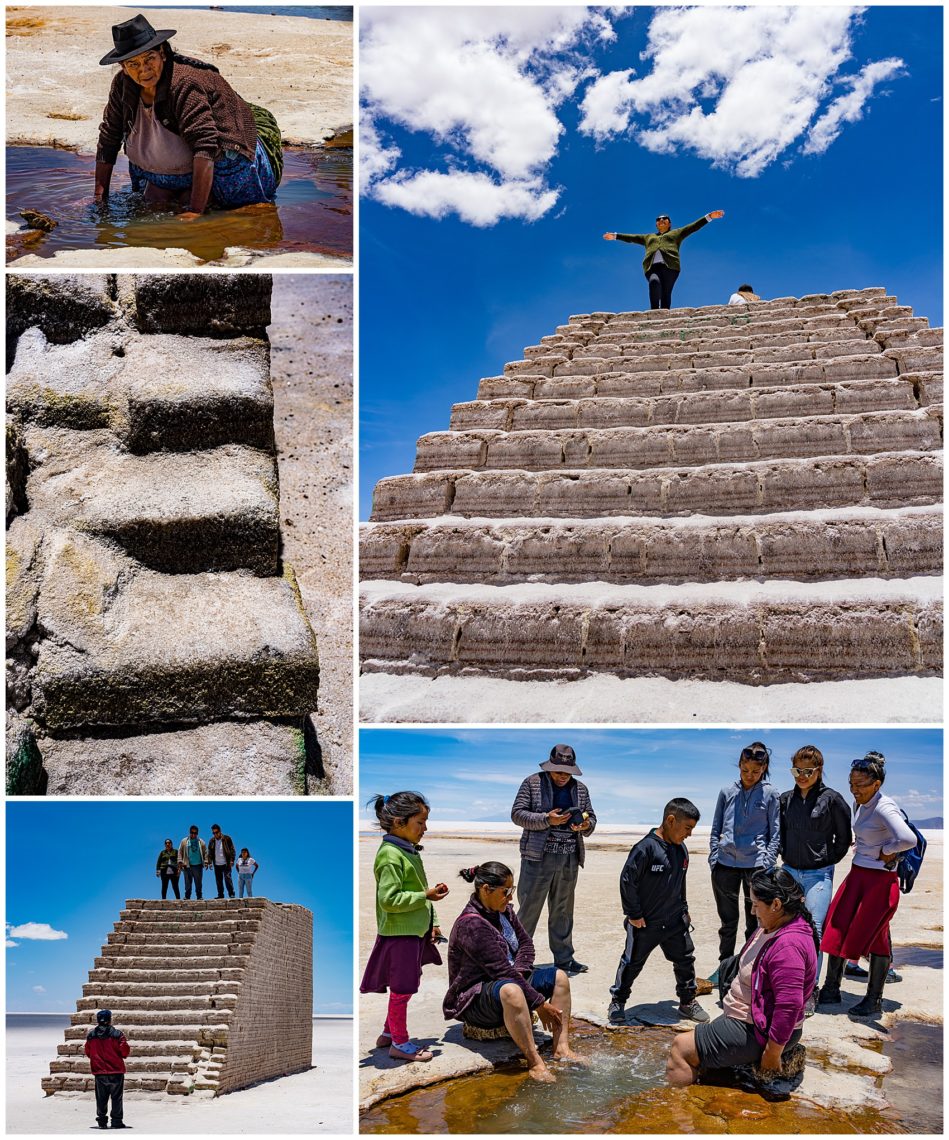
Another sculpture in the middle of nowhere (nothing visible for an hour’s drive in any direction) was named Stairway to Heaven. This was created for the 2020 Olympics held in Bolivia. When the salt flats are wet, the sculpture seems to float, and a person standing on top looks like they are standing on an infinite view of clouds, or Heaven. Originally there was a figure running up the stairs to light an Olympic fire at the top, all made of salt. Unfortunately, the Bolivian government removed those figures, but they did leave the stairs.
There is a natural springs that feeds water to a very small portion of the flats. There is a tradition to dip your feet into the baths (upper-left and lower-right). This spring is also “in the middle of nowhere,” though since it was on the route from the Stairs to our hotel, it was a nice 5 minute stop to stretch our legs and take the photographs shown.
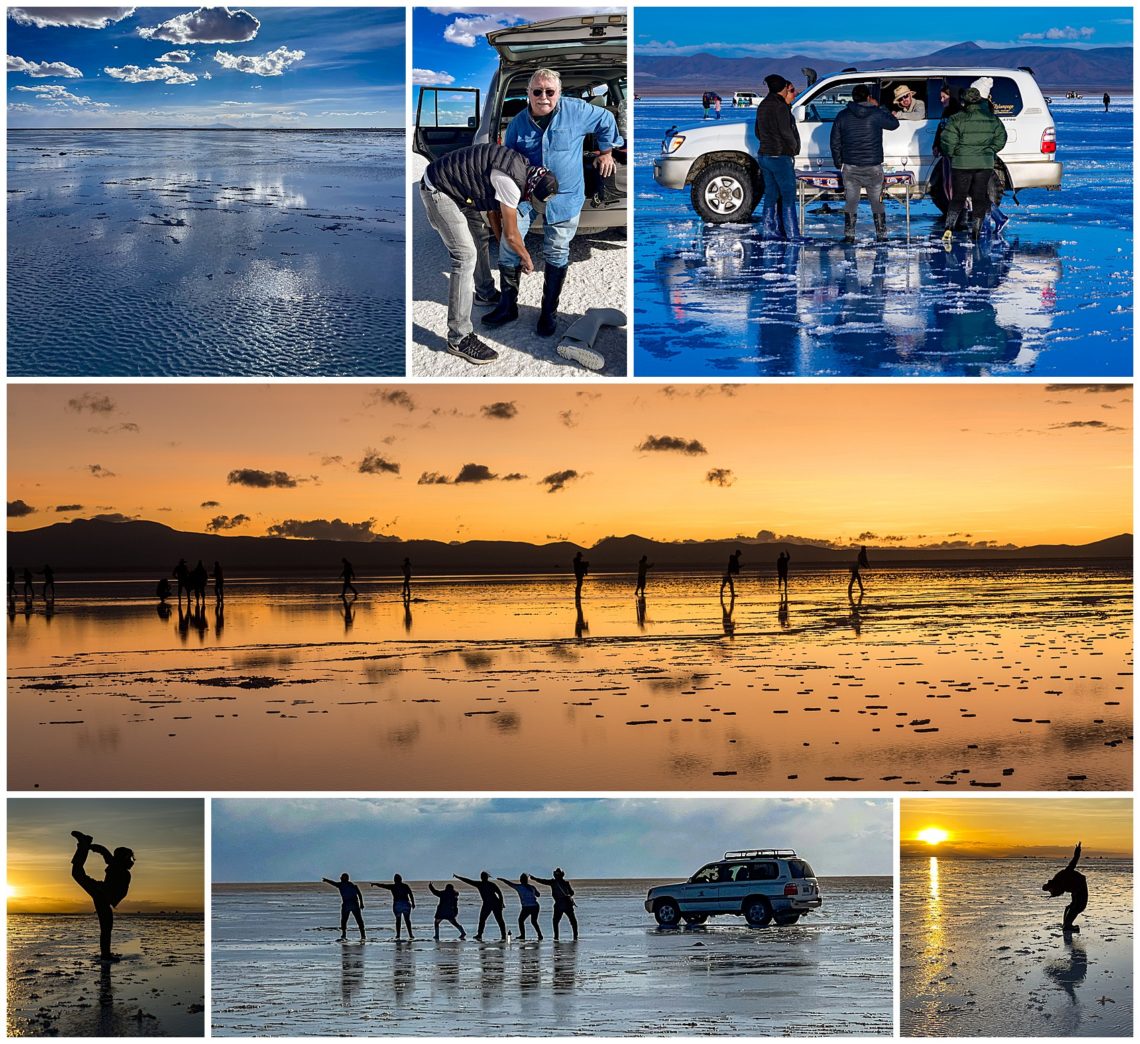
The Salt Flats at Uyuni is the largest in the world covering more than 4,000 square miles, and considered one of the most extreme and remarkable vistas, if you’re lucky. At sunset and sunrise, we saw reflections on the south end of the Uyuni Salt Flats, as seen in earlier blocks here. Before arriving at the salt flats, we had to put on heavy duty rubber boots, so we could stand on the water (top-middle).
There is a new activity that is quite popular with Korean tourists, where the driver circles his clients with movie camera and video tapes them while posing at the salt flats, with their reflections (middle-bottom). Ana was a contortionist from Argentina who posed for us (bottom-left and bottom-right). While waiting for the sunset, we shared a bottle of wine, plus snacks. Although Bolivia is in a drought, we were still able to experience the magical salt flats, even though not in the way we had originally envisioned.
